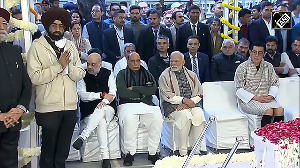They may be making the most expensive products, but India's craftsmen earn what any unskilled labour would earn.
Two young boys work at a silk weaving factory in Varanasi. They spend the day at school and work in the night shift at the loom, matching fine gold and magenta silk threads into a fine pattern, which is to become a sari worth Rs 20,000.
But the compensation they get is Rs 100 a day, the minimum wage under the Mayawati government.
The weavers in Varanasi are mostly Muslims. In fact, all the weavers who make Benaras silk are Muslims. One doesn't need a Sachar report to explain why they are poor and backward despite making the most expensive products.
The story repeats itself in the Jammu and Kashmir capital, Srinagar. Men, women and children work at the carpet units, many of them from home, weaving for days and often months to make extraordinary works of handicraft.
But what is the use of being repositories of such unique skills? The wages they get are never more than Rs 100 a day.
In Lucknow, which is known for its 'chikan' embroidery, the women and men who make the traditional embroidery, which is now in demand by fashion designers globally, earn just the minimum wages available for the rest of the masses.
At Seelampur in Delhi, in the tiny hutments visible from the Metro as a kind of tapestry of human inequality, parents and their many daughters and sons sit in the dim light of their hovels to make embroidery which cannot be replicated by anyone. But the work pays them little to help them get better living conditions.
The Ministry of Minority Affairs can do little about this. It has decided to pump funds into 330 towns, 90 districts and 100 artisan clusters identified as minority concentration places and trades. While Varanasi figures in the list, Kashmir is missing. But that is beside the point.
What can these initiatives do about improving their wages? It is for the labour ministry to amend the Minimum Wages Act to help artisans get money that is five or six times the prevailing minimum wages in their states.
J John, expert in labour issues who publishes Labourfile, agrees that wages for artisans have never taken into account their specialised skills.
That is the least the Government of India can do for these craftsmen who are carriers of a rich tradition. It makes social and economic sense to do so. It will achieve what the government seeks to do through targeted development of districts, towns and clusters for the minorities. It will be the equivalent of NREGP for the artisans.
It will make economic sense because the business of the artisan in Kashmir, Varanasi, Lucknow, Kanchipuram, Khurja or Ferozabad has no competition from cheap labour havens like China. And these products can and should get the price they deserve.
But organising them into groups or clusters would not necessarily enhance their earnings unless there is access to markets. That the country is yet to replicate Dilli Haat, which provides direct market for the artisans, reflects the vision and sincerity of various state governments.
So a significant solution lies in the amendment of the law itself. The sooner it is done the better. Not just for the artisans and minorities, but for the nation which is struggling to establish monopoly strongholds in the global market.
Or else the artisans would just vanish like they have in the Sonebhadra district of Uttar Pradesh, where carpet weavers are making village roads under the NREGP. Soon, makers of Benaras, Cashmere and Kanchipuram would follow suit. . . nothing could be more self-defeating for the country.







 © 2024 Rediff.com -
© 2024 Rediff.com -